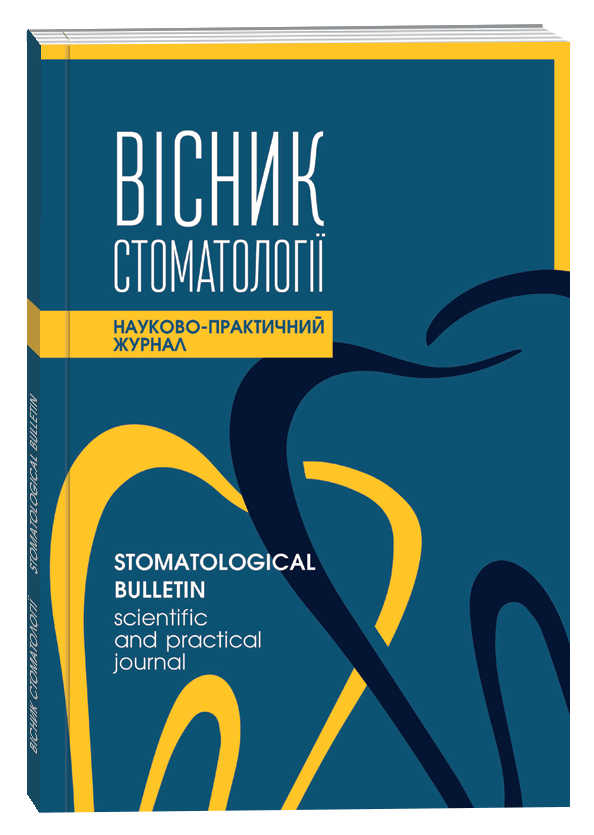RANDOMIZED CONTROLLED STUDY OF CLINICAL EFFICIENCY OF RESIN-BONDED BRIDGES
DOI:
https://doi.org/10.35220/2078-8916-2020-35-2-74-79Keywords:
resin-bonded bridges, direct method, retentional elements, design, reinforcement, clinical effi-ciencyAbstract
The article presents the results of a randomized controlled clinical study of prosthetics еfficiency with di-rect resin-bonded bridges made in different ways and dif-ferent terms of observations.
Objective. To evaluate a clinical efficiency of direct resin-bonded bridges with different designs.
Materials and methods. The study included 180 patients with dentition defects of short length. Patients were divid-ed into six groups, 30 people each, depending on the method of manufacturing resin-bonded bridges. Patients were scheduled for estimating of clinical efficiency the day after manufacturing bridges, 24 and 36 months. In order to assess the clinical condition of bridges used our own qualimetric system, according to which we deter-mined the compliance of prostheses with absolute and relative clinical criteria.
Results and discussion. After 24 months, the number of functioning prostheses without disorders of patients of groups III and VI was 29 prostheses in each group (96.7%). The efficiency of prosthetics of persons of II, IV, and V groups was lower, in particular, 23 prostheses (76.7%) in each group had no deviations. The number of successfully functioning bridges in patients of group I was the smallest and amounted to 20 prostheses (66.7 %).
After 36 months the clinical effectiveness of prosthetics was the highest in patients of group VI, being at the level of 28 prostheses (93.3 %). The number of perfectly func-tioning prostheses was lower in persons of III, II, V and IV groups, making 22 (73.3 %), 20 (66.6 %), 19 (63.3 %) and 17 (56.7 %) bridges, respectively. Only 14 prostheses (46.6 %) were installed in patients of group I without signs of any violations.
Conclusions. During three-year follow-up period, the highest clinical efficiency, which was 93.3%, were demonstrated by adhesive bridges made with the pro-posed design of retention elements and reinforced with fi-berglass tape and beam.
References
Sorohan M, Bjelikov O. Comparative characteristics of dental bridges with a minimally invasive preparation of abutment teeth (the literature review). Bukovyns'kyj medychnyj visnyk. 2017;21(1):224-9.
Boujoual I., El yamani A., Andoh A. Single dental res-toration by resin-bonded bridge. International Journal of Ad-vanced Research. 2018;6 (10):203-7.
Tacir I, Dirihan R, Polat Z, Salman G, Valittu P, Lasilla L, et al. Comparison of load-bearing capacities of 3-unit fiber-reinforced composite adhesive bridges with different framework designs. Medical Science Monitor. 2018;24:4440-8.
Augusti D, Augusti G, Ionescu A, Brambilla E, Re D. Fiber-reinforced composite resin bridges: an alternative method to treat root-fractured teeth. Restorative dentistry & Endodontics. 2020 Feb;45(1):1-9.
Escobedo M, Rodríguez S, Valdés J, Olay S, Mauvezín M. A new technique for direct fabrication of fiber-reinforced composite bridge: a long-term clinical observation. Dental Journal (Basel). 2020;8(2):48. DOI:10.3390/dj8020048
Scribante A, Vallittu P, Ozcan M, Lassila L, Gandini P, Sfondrini M. Travel beyond clinical uses of fiber reinforced composites (FRCs) in dentistry: a review of past employments, present applications, and future perspectives. BioMed Research International. 2018;8:1-8.
Rajak D, Pagar D, Menezes P, Linul E. Fiber-reinforced polymer composites: manufacturing, properties and applications. Polymers. 2019 Oct;11(10). DOI: 10.3390/polym11101667.
Scribante A, Vallittu P, Özcan M. Fiber-reinforced composites for dental applications. BioMed Research Interna-tional. 2018;2018:4734986. DOI:10.1155/2018/4734986.
Tuncdemir A, Guven M. Effects of fibers on color and translucency changes of bulk-fill and anterior composites after accelerated aging. BioMed Research International. 2018;Jan. 28:1-8. DOI: 10.1115/2018/2908696.
Udod A., Pompiy A, Shidlovsky N. Laboratory inves-tigation of the reinforced photo composition material bending strength. Modern Science. 2019;4:143-9.
Udod O, Pompij O. Sposib prjamogo vygotovlennja adgezyvnyh mostopodibnyh proteziv [Method of direct manufac-turing of adhesive bridges] Patent Ukrai'ny na korysnu model' № 130904. 2018. Bjul № 24.
Pompij O, Udod O. Kvalimetrychna systema ocinky klinichnogo stanu adgezyvnyh mostopodibnyh proteziv. Svidoctvo pro rejestraciju avtors'kogo prava na tvir [The system for evaluating the clinical state of adhesive bridges is symmet-rical. Certificate of copyright registration for the work no. 85034. 2019 January. 30].









